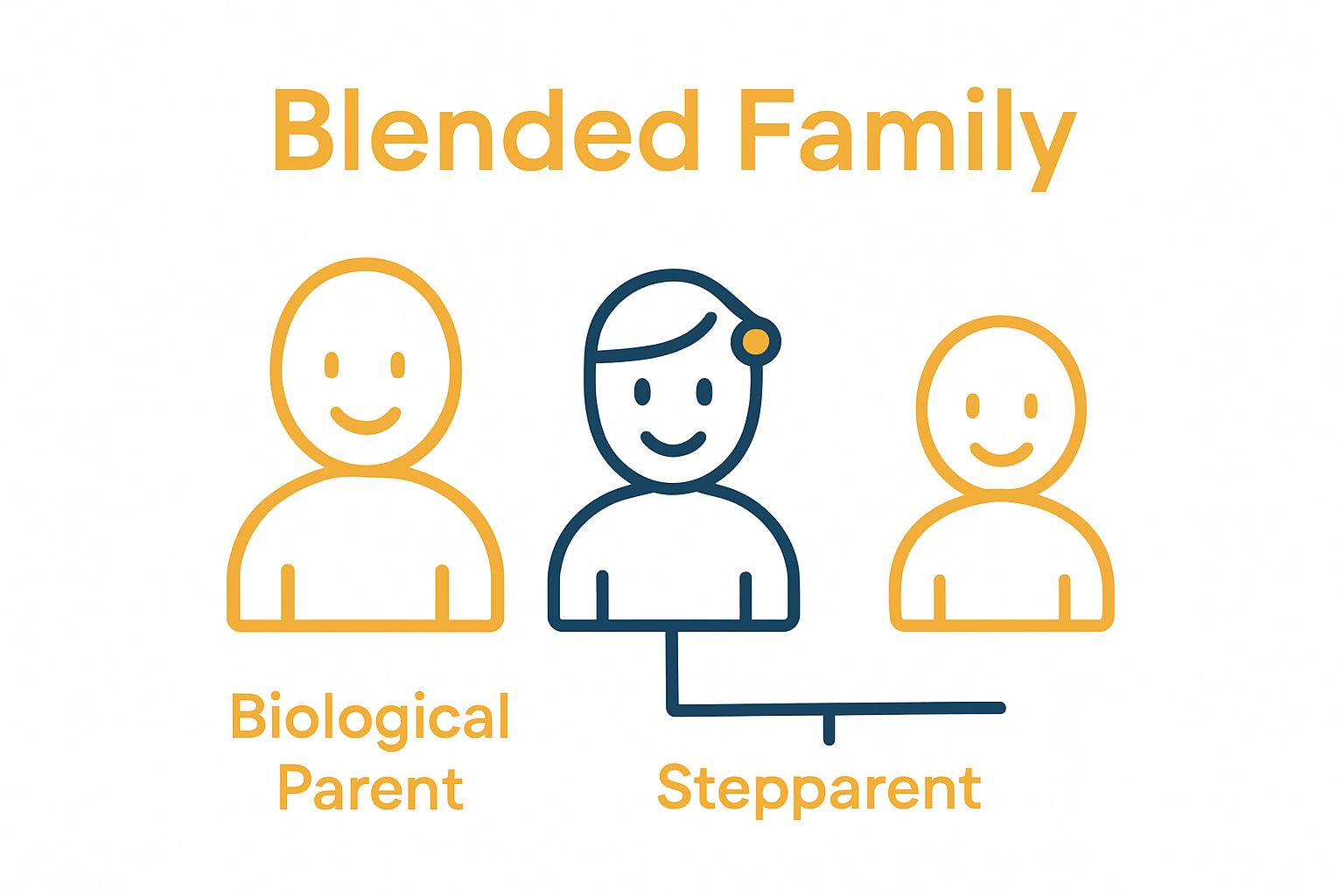
Blended families are becoming more common, making up a major part of how modern households look today. Legal frameworks have evolved to protect the rights of stepparents and stepchildren, which sounds like real progress. Yet what surprises many is that no law or piece of paper can sort out the emotional tangle inside these families. The real story is in how love, loyalty, and trust are rebuilt in ways no rulebook can predict.
Table of Contents
- What Are Blended Families And Their Structure?
- Why Blended Families And Marriage Matter In Today’s Society
- Social And Emotional Significance
- Economic And Psychological Implications
- Cultural Transformation And Resilience
- How Blended Families Navigate Relationships And Roles
- Establishing Clear Expectations And Boundaries
- Managing Emotional Complexity
- Building Unified Family Identity
- Key Concepts In Blended Families And Marriage Dynamics
- Emotional Intelligence And Relationship Mapping
- Role Negotiation And Power Dynamics
- Adaptive Family Systems
Quick Summary
| Takeaway | Explanation |
|---|---|
| Understanding blended family dynamics is crucial. | Blended families comprise biological parents, stepparents, and multiple connections; navigating this requires emotional intelligence and patience. |
| Clear expectations help avoid conflicts. | Establishing defined roles and communication can reduce ambiguity, fostering a more harmonious family environment. |
| Emotional complexity is a significant challenge. | Family members must manage feelings of loyalty and grief, making emotional navigation essential for maintenance and growth. |
| Building a unified family identity takes effort. | Shared traditions and regular meetings can cultivate emotional connections among blended family members, promoting togetherness. |
| Adaptive systems enhance relationship dynamics. | Successful blended families evolve by leveraging flexibility, open communication, and respect for individual differences to enhance familial harmony. |
What Are Blended Families and Their Structure?
Blended families represent a complex and increasingly common family structure where two partners combine their households, bringing children from previous relationships into a new family unit. According to the American Psychological Association, these families emerge through remarriage or partnership after divorce, separation, or widowhood.
Understanding Family Composition
A blended family typically involves biological parents, stepparents, stepsiblings, and half-siblings who live together and function as a unified family system. The structure can vary widely, creating unique dynamics that differ from traditional nuclear families.
Below is a table summarizing the key components often found in blended family structures for quick reference and comparison.
| Family Role | Description |
|---|---|
| Biological Parent | A parent who has a biological connection to one or more children |
| Stepparent | A parent married to a biological parent but not biologically related |
| Stepsibling | Child of a stepparent, no biological connection to other children |
| Half-sibling | Child who shares one biological parent with another child |
| Child | May refer to biological, step, or half-siblings in the household |
| Extended Family | Grandparents, aunts, uncles from either biological or step relations |
 Key characteristics include:
Key characteristics include:
- Multiple parental figures with different biological connections
- Children adjusting to new family roles and relationships
- Complex emotional landscapes involving loyalty, acceptance, and integration
Challenges in Blended Family Dynamics
Navigating a blended family requires significant emotional intelligence and patience. Unlike traditional families, these households must manage intricate relationships, potential loyalty conflicts, and varying expectations from different family members. Children may experience complex emotions about accepting new parental figures, while parents must balance nurturing biological and stepchildren equally.
Legal and Social Recognition
Modern society increasingly recognizes blended families as a legitimate and valuable family structure.
This comparison table highlights the core differences between traditional nuclear families and blended families, emphasizing unique characteristics and challenges.
| Aspect | Traditional Nuclear Family | Blended Family |
|---|---|---|
| Family Structure | Two parents, biological children | Stepparents, stepsiblings, biological children |
| Emotional Complexity | More predictable dynamics | Increased loyalty conflicts and adjustment periods |
| Legal Considerations | Standard parental rights | Evolving legal rights for stepparents and stepchildren |
| Social Perception | Often viewed as the standard | Growing acceptance but still faces some stigma |
| Role Clarity | Clearer parental roles | Ambiguity in roles and boundaries require negotiation |
| Adaptability Requirement | Moderate | High—requires ongoing negotiation and flexibility |
| Legal frameworks have evolved to provide protections and rights for stepparents and stepchildren, acknowledging the important emotional bonds that transcend biological connections. Social perspectives have also shifted, reducing stigma and promoting understanding of diverse family configurations. |
Blended families demonstrate the remarkable adaptability of human relationships, showing that family is defined not just by blood, but by love, commitment, and mutual support.
Why Blended Families and Marriage Matter in Today’s Society
In an evolving social landscape, blended families represent a profound transformation in how we understand relationships, commitment, and familial bonds. Recent sociological research from the Pew Research Center indicates that traditional family structures are rapidly changing, with blended families becoming increasingly common and socially accepted.
Social and Emotional Significance
Blended families are more than just statistical shifts they are living examples of human adaptability and emotional resilience. They challenge traditional notions of family by demonstrating that love and commitment transcend biological connections. These families represent a complex network of relationships that require:
- Emotional intelligence and empathy
- Flexible communication strategies
- Mutual respect across different family backgrounds
Economic and Psychological Implications
The rise of blended families also carries significant economic and psychological dimensions. Our guide on understanding traditional marriage values explores how these new family structures impact societal norms. Children in blended families often develop stronger interpersonal skills, adaptability, and broader perspectives on relationships due to their diverse family experiences.
Cultural Transformation and Resilience
Today’s blended families symbolize cultural evolution and human resilience. They challenge outdated stereotypes and demonstrate that families can be constructed through love, choice, and mutual understanding rather than solely through biological connections. These families showcase the potential for healing, growth, and rebuilding after significant life transitions like divorce or loss.
Ultimately, blended families remind us that family is not defined by a single model, but by the depth of connection, mutual support, and shared commitment to collective well-being.
How Blended Families Navigate Relationships and Roles
Research from the National Institutes of Health reveals that successful blended families require intentional strategies for managing complex interpersonal dynamics. Navigating relationships and roles demands extraordinary emotional intelligence, patience, and commitment from all family members.
Establishing Clear Expectations and Boundaries
Successful blended families recognize that ambiguous roles create potential conflicts. Family members must proactively define relationship boundaries, communication protocols, and mutual expectations. Our guide on clear roles and responsibilities in marriage provides deeper insights into this critical process.
Key strategies for establishing clarity include:
- Creating transparent communication channels
- Defining stepparent roles respectfully
- Developing consistent disciplinary approaches
- Allowing space for individual and collective emotional processing
Managing Emotional Complexity
Emotional navigation represents the most challenging aspect of blended family dynamics. Children and adults alike must manage complex feelings of loyalty, potential grief, and adjustment. Stepparents cannot replace biological parents but can develop unique, meaningful relationships through consistent respect, patience, and genuine emotional investment.
Building Unified Family Identity
Transforming a collection of individuals into a cohesive family unit requires deliberate efforts. Shared experiences, family traditions, and mutual respect become the glue binding different backgrounds together. Regular family meetings, collaborative decision making, and creating new shared memories help transform biological strangers into an emotionally connected family system.
Successful blended families understand that relationships are not predetermined but carefully cultivated through continuous communication, empathy, and commitment.

Key Concepts in Blended Families and Marriage Dynamics
According to the American Psychological Association, blended families represent a complex social structure with unique psychological and emotional challenges. Understanding the fundamental dynamics requires exploring nuanced relationship principles that differentiate these families from traditional nuclear households.
Emotional Intelligence and Relationship Mapping
Emotional intelligence becomes the cornerstone of successful blended family integration. Family members must develop sophisticated interpersonal skills to navigate intricate relationship networks. Our guide on understanding remarrying after divorce provides deeper insights into these complex emotional landscapes.
Key relationship mapping strategies include:
- Recognizing individual emotional boundaries
- Understanding potential loyalty conflicts
- Developing empathetic communication patterns
- Acknowledging each member’s unique emotional journey
Role Negotiation and Power Dynamics
Blended families require continuous negotiation of roles and responsibilities. Stepparents and biological parents must collaborate to create consistent, supportive environments without undermining existing familial connections. This delicate balance involves understanding power dynamics, respecting pre-existing relationships, and creating new family narratives.
Adaptive Family Systems
Successful blended families function as adaptive systems, continuously evolving to meet changing emotional and practical needs. They demonstrate remarkable resilience by transforming potential challenges into opportunities for deeper connection. The ability to create flexible boundaries, maintain open communication, and embrace individual differences becomes crucial for long-term family harmony.
Ultimately, blended families reveal that love transcends traditional biological connections, showcasing human capacity for compassion, understanding, and collective growth.
Ready to Strengthen Your Blended Family Dynamics?
Managing a blended family brings unique emotional challenges, from setting clear roles to balancing loyalty and communication. Pain points like unclear expectations and the struggle to integrate stepparents can leave you feeling uncertain about your role as a leader, husband, or partner. If you are looking for real solutions to build deeper trust and a more connected family life, you do not have to navigate this alone. Tap into proven relationship strategies and practical, everyday insights with our Daily Relationship Wisdom collection to discover what works in real blended households.

Join the community at WiseHusband.com and access guidance tailored to men who want to thrive as confident partners in complex family structures. Take the next step now and give your marriage the wisdom it deserves for lasting love and respect.
Frequently Asked Questions
What defines a blended family?
A blended family is formed when two partners merge their households, including children from previous relationships. This family structure may consist of biological parents, stepparents, stepsiblings, and half-siblings.
What challenges do blended families face?
Blended families encounter unique challenges such as managing complex relationships, potential loyalty conflicts, and differing expectations among family members, requiring emotional intelligence and patience to navigate.
How can blended families establish clear roles and expectations?
Successful blended families can define clear roles and expectations by creating open communication channels, establishing stepparent roles, and developing consistent disciplinary approaches to avoid ambiguity in relationships.
Why is emotional intelligence important for blended families?
Emotional intelligence is crucial for blended families as it helps family members navigate complex interpersonal dynamics, manage emotions regarding loyalty and adjustment, and develop meaningful relationships despite varied family backgrounds.
Recommended
- Understanding the Importance of Marriage Counseling
- Understanding Remarrying After Divorce: Key Insights - Wise Husband
- Understanding Why Marriages Fail: Common Factors Explained
- Understanding the Causes of Marital Conflict
Get the Wise Husband Book
https://wisehusband.com/understanding-blended-families-and-marriage/?fsp_sid=1323

No comments:
Post a Comment